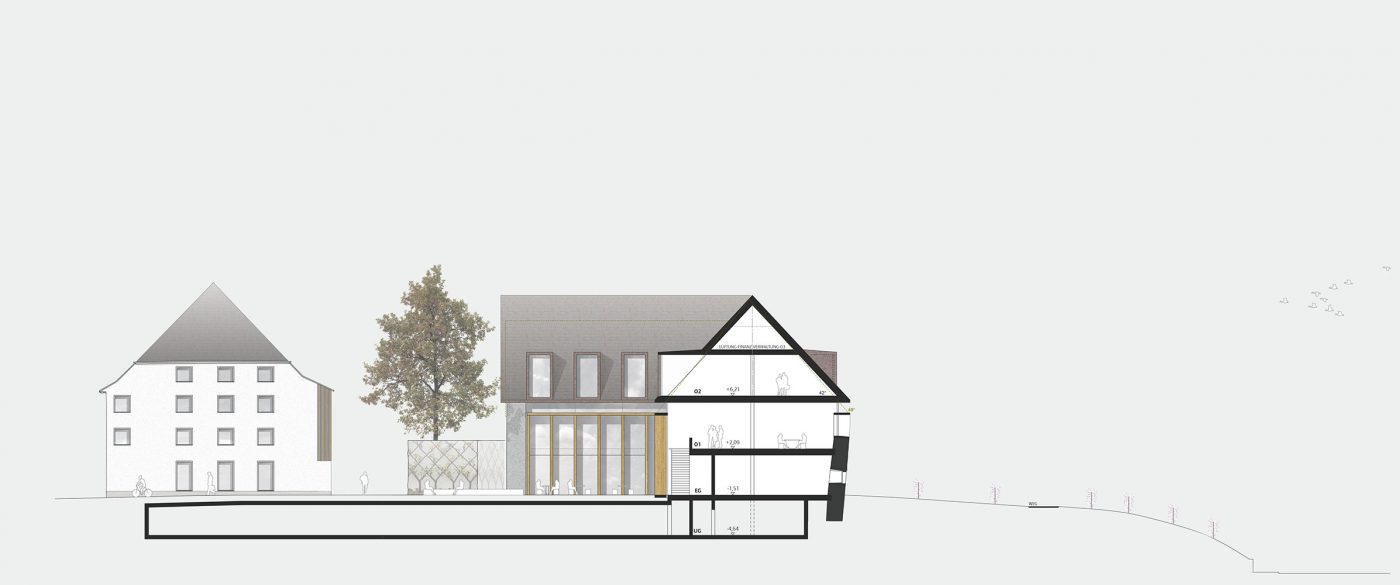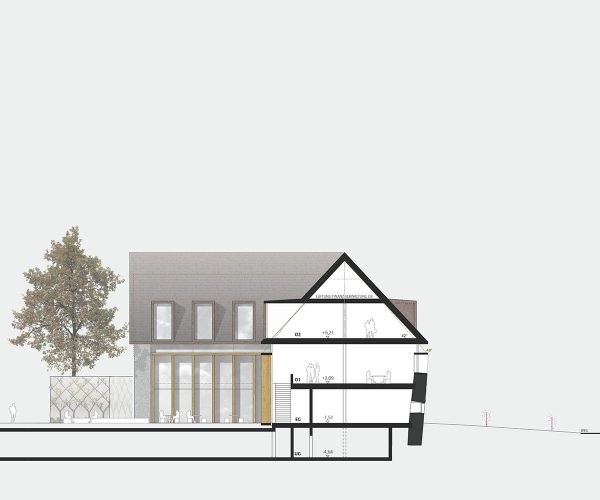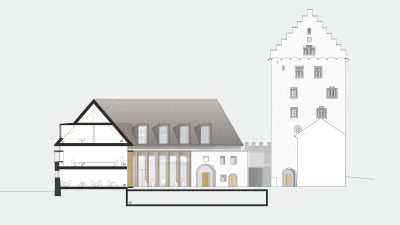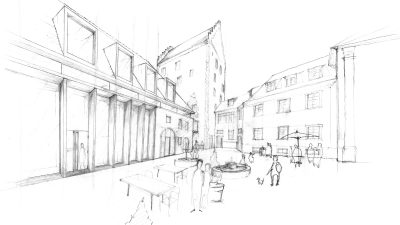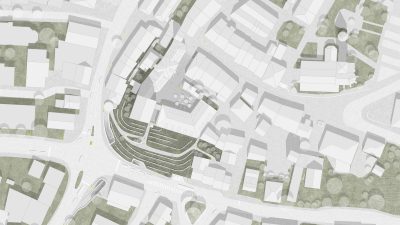Project Information
Builder-Owner
Stadtverwaltung Markdorf
Location
Markdorf (D)
Competition
2016
Project facts
Rights
Text Hermann Kaufmann + Partner ZT GmbH,
Translation Bronwen Rolls
Image Hermann Kaufmann + Partner ZT GmbH
- Outside Facilities Planning
DI Markus Cukrowicz Landschaftsarchitekt, Winterthur
Rathaus, Markdorf
The exterior qualities of the historical ensemble are elaborated with a few precise interventions. The tower is freed from the massive staircase, and therefore strengthened in its meaning and perception. This also creates a direct link from Schlosshof to Schlossgarten. The city wall in the area Schlossscheuer should correspond more to its original character by reducing the wall and roof openings from the 1980s.
The location at the castle courtyard should be enriched due to its importance as the gateway to the old town. All entrances are oriented to the courtyard. The underground car park development will be relocated from the Schlossgarten to the Schlosshof. As a spatial conclusion of a side street to the Marktstraße, the castle’s courtyard should invite people to linger.
In addition to the town hall, it needs a second, well-frequented use that further strengthens the location and also contributes economically to the success of the project. For this purpose, the largest possible gastronomy area is proposed. The gastronomy is directly connected to the meeting area, and together with the other rooms in the Bishop’s Tower, and the unique location, has a high potential for events of all kinds.
An inviting and clear development concept is the basis for the success and acceptance by the residence. The existing entrance to the castle has been altered historically and appears from today’s perspective as a clear approach for the town hall. The labyrinthine hotel complex does not meet the requirements of a modern city with simple orientation and short distances. To improve the accessibility, the New Castle and the tower are connected directly to each other on all three storey levels. In the connection construction, the common emergency staircase, with elevator will be rearranged. A generous access road on the first floor connects the meeting area in the Schlossscheuer directly with the administration offices. Employees get from the underground car park directly to this level.
All distributed administration areas in the buildings are served by the adapted access structure. The upper floors of the new castle and the visitor’s toilet in the basement are reached by new stairs directly from the foyer.
The areas municipal bodies and main offices are located in the Baroque rooms centrally near the entrance. The frequently used public administration office occupies the entire second floor. The buildings office is located in the tower and the financial management in the attic of the castle barn. The personnel area is centrally located in the tower. Marktstraße 17 is also used as part of the administration services, keeping as much of the space as possible for the gastronomy and event use in the Bishop’s Castle. The integration of apartments also appears to be a hindrance to the future development of the Rathaus ensemble. From our point of view, the personnel and EDP department can most likely be accommodated here, since a high level of discretion is required, especially in staff discussions.
By incorporating the exit staircase, the two storeys of impressive oak construction are unlocked in the tower. The connection to the development also makes these rooms easily accessible and visible. The room on the ground floor can be used for events and exhibitions. An additional window on the west, facing away from the city helps to improve the feeling of space. The newly created connections of the Bishop’s Castle, New Castle and Schlossscheuer require only four new wall breakthroughs. The wedding room in the Knights’ Hall is not affected by the new staircase; with multi functional furniture no further room installations are required. To make the impressive roof trusses noticeable, the sixth floor in the tower should be used as an office space. Even in the New Castle, the loft space is proposed to be a meeting room.
The meeting area covers the entire first floor of the Schlossscheuer and can be flexible due to mobile partition walls. The administration area is directly connected via a bridge. The tea kitchen and foyer can be operated for events directly from the kitchen. The Bürgersaal offers visual references to the Schlosshof, Schlossgarten and Hexenturm. The gastronomy on the ground floor has a guest room with garden. Delivery is via the farm. The toilets are in the gastronomy, the meeting area and also publicly available (eg Advent market). The common foyer can be used outside the opening hours and is separated from the underground car park access. The access to the garage can be left open 24 hours. In order to rule out any conflicts of use, a separate lift is planned for the garage.
Contrary to the hotel building from the 1980s, where attempts were made to create a synthesis by merging the old and the new, the present proposal suggests a deliberate separation of formal languages. The architectural concept pursues the goal of building a creative tension through a deliberate juxtaposition and superimposition of the different layers. In the process, the new building fits into the existing ensemble through greatly reduced choice of form and material.
An emergancey staircase is planned for the tower. The smoke extractors are made using mobile fire protection elements. The smoke extraction takes place via the facade. In the new building of the Schlossscheuer two escape staircases are planned, which ensure the evacuation of the underground car park and meeting place. All rooms of the Schlossscheuer, as well as the wedding room and the showroom in the tower, are proposed to include controlled ventilation. For heating, a heat pump with ground probes would be the most sustainable solution.
Opposites attract. In the area of tension between the flat, hard-stamped Schlossplatz square and the inclined, green-covered castle garden, a very clearly discernible thematic arc spans out, emphasising the urban significance of the palace ensemble.
The plaster pavement of medium to dark grey natural stone, which was proposed for the Schlossplatz, deliberately deviates from the remaining porphyry covering from the 1980s. The grey coating is capable of absorbing and bonding together all the colours and materials. It forms the necessary, optically restrained framework for combining the clearly perceptible historical sedimentation layers. Via the pixel-like transition the visitor glides smoothly from the city body into the Schlosskomplexhof. Trellises of fruit cover the rear wall of the outbuildings. A massive seat element made of stone and oak corrects the slanted building corner. A low, but generous fountain accentuates the patio, which is furnished with mobile furniture and stylish potted plants and is now available for all types of temporary use.
Based on the historically documented use of the garden in the city walls, the southern slope is interpreted as a decorative garden enriched with a decorative and representational forms. Instead of the regionally typical grapevines, a horizontal, succession of high-altitude grading lines of blue characterise the slope. The horizontal contrasts and emphasises the defensive and defiant expression of the tower. The crash problem with underpass and underground parking can also be solved inconspicuously with a continuous ranking element.
The paved asphalt path connects the adjoining points and creates an accessible entry. An upholstered seat element allows a short stay in the garden overlooking the tower. Spring colours the entire slope with thousands of flowers of scilla, crocus and narcissus. Subsequently, the slope turns into an imposing waterfall of white and blue wisteria spikes. After the yellow autumn colouring, the bizarre and painterly winding branch structures of the wisteria shape the unmistakable appearance of the now classically modern castle garden.
